Figure 1
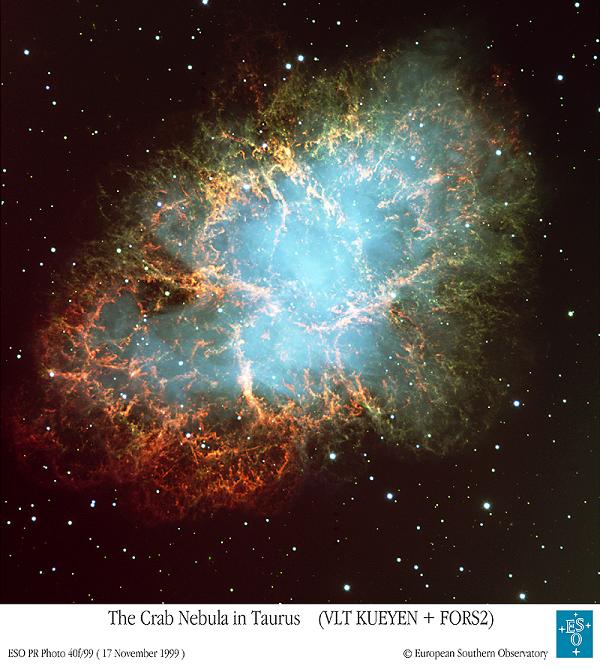
THE CRAB NEBULA AND THE COMPLEX DOMAIN
By Jonathan Tennenbaum
It is a fair guess, that the Crab Nebula will play a comparable role, in a coming series of revolutions in astrophysics, to that of Mars' anomalous motion in Johannes Kepler's launching of modern astronomy four centuries ago. The anomalies of the Crab Nebula confront us directly with the issue of the interrelationship between the Sensorium of perception and the manifold of efficient physical principles, that Lyn addressed in his recent paper on "Visualizing the Complex Domain". Ironically, any person who has mastered Lyn's paper, will be incomparably better qualified, to grasp the fundamental question posed by the Crab Nebula, than 99% of today's professional astrophysicists!
The present state of astronomy and astrophysics, exemplify the way empiricism has killed science. The Platonic method of hypothesis, upon which Johannes Kepler founded the science of astrophysics, has been suppressed. Instead, "scientific method" is fraudulently equated with the practice of interpreting and "explaining" data according to the supposedly authoritative "laws of (textbook) physics". Thereby, the contemporary astrophysicist degrades himself to the level of an animal, that interprets sense perceptions according to blind instinct. The equivalent of animal instinct, which controls the afflicted scientist's mind in this case, is adherence to "accepted norms of academic performance", engrained in the student through drilling in the methods for "getting the right answer", and enforced among professionals by fear of being ostracized from the "scientific community".
Moreover, astrophysics has been perverted by the monstrous concoction known as "modern cosmology", with the imposition of arbitrary, ivory-tower doctrines, such as the "Big Bang", that have no basis in the actual astronomical evidence. Continuing in the line of the bogus, entropic "theories" of Laplace and Kant, the "Big Bang" and related fairy-tales work as a cover for a veritable inquisition against original scientific inquiry, and of a suppression of scientific evidence, that rivals the Dark Ages of Aristotle and Ptolomy.
The resulting, "official" doctrine of the Universe, admits no true principles, no generation of ideas, and therefore no possibility for Man to transform the Universe. It is expressly designed to make people feel tiny, impotent and morally indifferent, as Kant recommended in his monstrous 1755 treatise, "General Natural History and Theory of the Heavens, or Attempt to Account for the Nature and Mechanical Origin of the Entire Universe according to Newtonian Principles." By imposing a false, Euclidean-Cartesian projection of reality in terms of a supposed primacy of scalar extension, galaxies and other astronomical objects -- which in fact are located at "virtually zero distance" from us in the causal ordering of the Universe -- were made to appear "hopelessly far away" and inaccessible to Man. By the same token, human Reason and Man's own activity in the Universe, were made to appear as if totally irrelevant, and Man himself to shrink to almost nothing, relative to the inhuman vastness of thousands, millions or billions of light years, that supposedly characterizes the "objective" Universe around us.
But, the situation is overripe for revolution. Ironically, while the process of creative hypothesis-formation in astrophysics has all but collapsed, major advances have occurred in the technology of astronomical observation, exemplified by the development of X-ray and gamma-ray telescopes; the stationing of telescopes and other astronomical instruments in orbit; and the advent of "very long baseline" interferometry, creating the effect ("synthetic aperture") of a radio telescope the size of the Earth's diameter. These technological advances have led to an unprecedented proliferation in the number and variety of astrophysical anomalies, just waiting for a new Johannes Kepler to appear on the scene, and to liberate science from the chains of the Enlightenment.
Will such a new Kepler emerge from the ranks of a victorious LaRouche Youth Movement? Many Keplers, we should hope! In the meantime, the following introduction to the Crab Nebula should provide a foretaste of the delights in front of us.
A first look at the Crab Nebula
The Crab Nebula (M1 in the classification of Messier) is located in the night sky in the constellation Taurus. While not directly visible to the naked eye, it appears in low-power telescopes as an approximately elliptically-shaped, luminous cloud, whose long axis describes an angle of 5 minutes of arc "on the celestial sphere". The apparent minor axis of the Crab is about 3 minutes of arc across (1).
The Crab Nebula was first noted around 1731, as an oval-shaped nebulous patch in sky. By the middle of the 19th century, with the rapid improvement of telescopic instruments, a complex of irregular filaments became visible within the nebula, inspiring the name "the Crab". In the course of the 20th century, the region of the Crab Nebula was found to be a powerful source of radiation, spanning practically the entire known electromagnetic spectrum -- from radio waves, microwave and infrared radiation, across the visible spectrum, all the way through the ultraviolet and X-ray ranges, into the domain of ultra-short-wavelength gamma-rays ("cosmic rays").
In the meantime the development of astrophysical instrumentation, has made it possible to register the emissions from Crab Nebula over a large section of the above-mentioned "registers" of electromagnetic radiation, mapping the intensity (and sometimes polarization and spectral characteristics) of the radiation received, in the given wavelength interval, as a function of direction on the celestial sphere. The result is a growing array of images, all covering the same angular area on the celestial sphere, but differing very greatly from one electromagnetic "register" to the other, and also changing in time in a most extraordinarsy fashion.
Figure i s a recent, very beautiful photograph of the Crab in the visible wavelength-range, taken by the European Southern Observatory.
|
Figure 1 
|
Figure 2 shows a set of four images, made with visible, infrared, radio frequency and X-ray radiation -- all totally different! (Note: the images are not all on the same scale.)
|
Figure 2 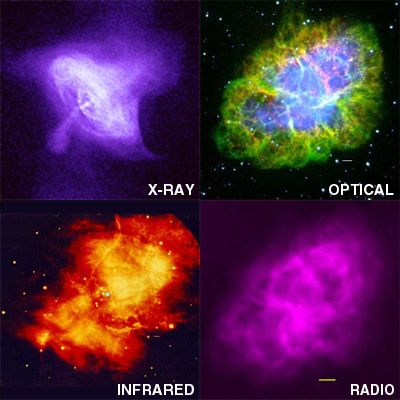
|
Seeing with your mind, not just with your eyes
The contrast between the images immediately raises the question: If the "real" object not any one of those images -- projected, as it were, on the extended Sensorium of astronomical instruments -- then what kind of object is it, that we are observing? The question prompts a brief aside, before getting on with the Crab.
Take a very simple illustration from everyday life. You report to someone, "I saw Jonathan today". This statement could mean different things, and be truthful or untruthful, depending on how you intended the verb, "saw". If "to see" meant nothing more than an act of visual perception, then the statement could not possibly be true; since for sure you perceived only Jonathan's face, not the actual person! For, a human personality is not a visible object! A human personality -- a mind -- can be recognized and known only to the cognitive processes of another mind. The report, "I saw Jonathan", could only be truthful, if the verb, "saw", subsumed a cognitive process in your mind, by which you identified and conceptualized a specific human personality, lying "behind" the image of the face and other effects, your sense perception reported to you.
What then is the character of the object of astronomical observation? What does today's astronomer have in mind, when he says "I have been observing the Crab Nebula"? Does he simply mean, that he has pointed his telescope or other instruments at a certain luminous smudge in the heavens, and registered certain signals? No doubt, the astronomer means more than that. He will claim he was observing a "real object out there". But, what sort of object does he have in mind? How could he demonstrate that "it" actually exists, as an efficient entity in the Universe, in the way he thinks it does?
From the standpoint of naive sense-certainty, the modern astrophysicist does not "observe" the Crab Nebula in any direct sense (the luminous smudge is anyway not directly visible to the naked eye!) What he observes, is something happening to certain physical systems, called scientific instruments, which the astronomers have developed as "generalized sense organs". The action, the "happening" ,is occuring at the location of the instruments, not at the putative location of the Crab Nebula, many light years away! Sometimes the events the astronomer studies, are nothing but certain harmonic correlations of phase among signals generated in a network of instruments. Yet he ascribes these events to that remote, unseen object: the Crab Nebula!
All this underlines the fact, that there is no simple, self-evident relationship between the processes of perception or "observation", and "the object itself". That relationship depends exclusively on the cognitive powers of the human mind, to adduce the existence of thought-objects, in the form of principles lying beyond the reach of mere sense perception, and to demonstrate their efficiency over the phenomena of the Sensorium.
The Crab in the Sensorium of "multiwavelength astronomy"
Now return to the images themselves. Figure 3 shows photographic images of the Crab Nebula, taken in blue and red wavelengths of visible light. Note, that the complex fabric of filaments, that appear in red light, but are virtually absent in blue. That outer, filamentary "cocoon" of the Crab displays characteristic, sharply defined spectral lines, differentiating it from an inner core, whose emission is continuously distributed over the entire electromagnetic spectrum.
|
Figure 3 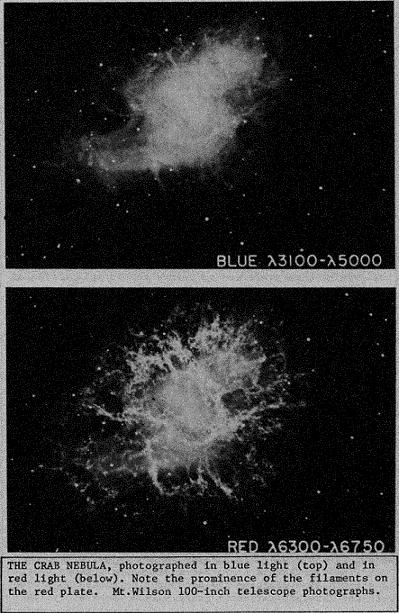
|
Figure 4 is a closeup of the filaments, taken with the Hubble orbital telescope in visible wavelengths. The highly-organized morphology of the filaments is astonishingly reminiscent of certain types of living tissue.
|
Figure 4 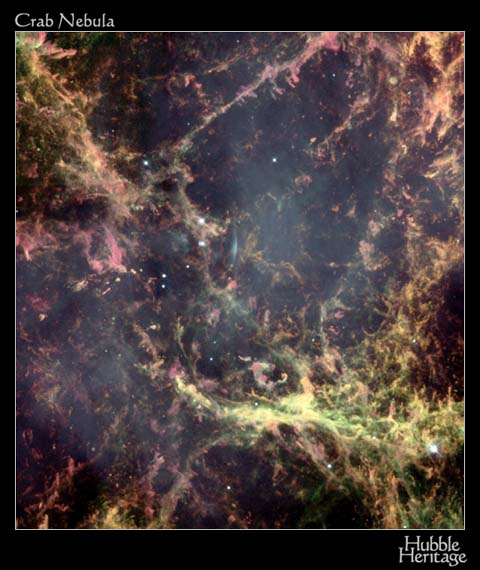
|
Figure 5 shows the Crab photographed in the visible light range, but with filters selecting light with different angles of polarization. The striking difference in overall strength between the two, shows that the whole, gigantic system possesses a strong axis of polarization. Presumably, the Nebula as a whole is powerfully magnetized.
|
Figure 5 
|
Most extraordinary, Figure 6 shows an image produced in the shortest of the four wavelength-ranges, X-rays, by the orbiting X-ray telescope Chandra during 1999-2000 The X-ray-emitting region appears to coicide with the core of the Crab Nebula. It is organized around a clearly-defined axis which coincides roughly with the long axis of the Crab as a whole, as well as the axis of polarization; it has a toroidal structure with smaller concentric rings and a variety of rapidly-changing features.
|
Figure 6 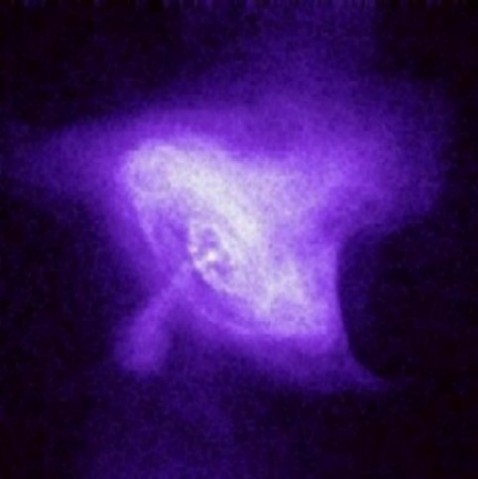
|
Figure 7 shows a superposition of photos taken in the visible and X-ray wavelengths, from which you can see the location and proportions of the X-ray-emitting "core" to the Crab Nebula as a whole (here the outer filaments do not show) This can also be seen on Figure 1, where the outer filaments come out strongly, and the core is faintly visible.
|
Figure 7 
|
Located on the axis of symmetry of the X-ray torus, in the middle of the entire structure, lies a highly anomalous object, key to the entire Crab Nebula: a star that emits repeated, powerful pulses of electromagnetic radiation, in almost the entire spectrum from radio to gamma-rays, at a precise rate of 30 pulses per second! The stills and time-lapse movie of this "Crab pulsar" show huge jets of magnetized, X-ray-emitting plasma, flowing outward from what are presumably the polar regions of the star, along the axis of the torus in both directions, then curving off on both sides as if to form an "S"-shape, and perhaps continuing out into the outer tissue of filaments.
Again, the harmonic features of X-ray core region, plus its striking left-right dissymmetry, are coherent with Leonardo and Pasteur's observations on the characteristic morphology of living processes.
The reader should now view the time-lapse movie of the X-ray region of the Crab, which can be downloaded from the website: http://chandra.harvard.edu/photo/2002/0052/movies.html
The movie referred to is the middle one of the three on the cited page, entitled "Chandra timelapse movie". It is made from 7 successive images of the Crab, taken at approximately 21-day intervals by the Chandra orbiting X-ray telescope between November 2000 and April 2001. Figure 8 shows the sequence of stills from which the movie was made. (Note: The sequence is repeated several times, in a loop, to make it longer. The resulting impression of periodic pulsation, is an artifact of the editing, and has nothing to do with the much shorter, 33 millisecond pulsing of the central star.
|
Figure 8 
|
This time-lapse movie displays most strikingly, what has long been discussed as a central, anomalous feature of the Crab: processes in different locations of this gigantic object, are evidently synchronized with each other, in a fashion that can hardly be explained on the basis of a point-to-point propagation of "signals" or other influences between those locations. Note the coherent, synchronous changes in prominent features of the X-ray-emitting core, including the evolution of "hot spots" on the inner X-ray ring, the concentric outward-moving shock waves, as well as synchronous changes on the larger, concentric "torus".
These changes are occurring at what, for a system of astronomical dimensions, is an extraordinarily rapid rate. From the movie, in fact, there is nothing to suggest to us, that we are looking at an object possibly many light-years across. There is nothing in the pattern of changes of the Crab as a whole, for example, that suggests that the Crab experiences any significant limitation connected with the finite velocity of propagation of light, for example.
This raises the question, how "big" the Crab Nebula "really is". Interestingly, it is the growth process of the Crab that provides the chief means for estimating its approximate scale.
A growing anomaly
Figure 9a shows an image of the Crab, taken in 1973, and Figure 9b shows an image of the crab taken in 2000. Close comparison of the superimposed images, particularly the details of the filamentary structure, suggests that the Crab Nebula -- or at least, the outer, "cocoon"-like outer shell of filaments -- is constantly expanding! Systematic comparison of photographs, taken over the last 80 years, show that the outer filaments of the Crab are expanding radially from the center of the Crab, at an overall average rate of 0.1 seconds of arc per year as seen from the Earth. Accordingly, the apparent angular size of the Crab, as seen on the celestial sphere, grows by twice that amount, i.e. 0.2 seconds of arc per year as seen from the Earth.
|
Figure 9a 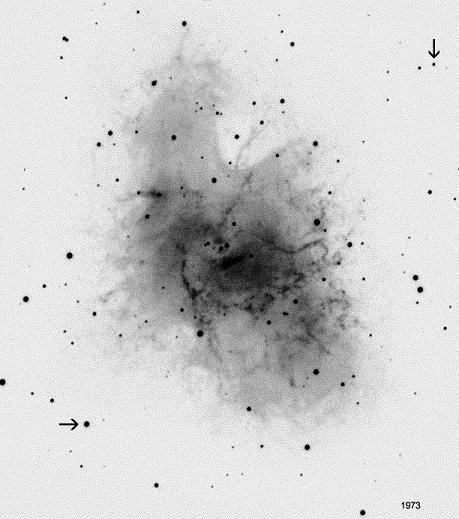
|
Figure 9b 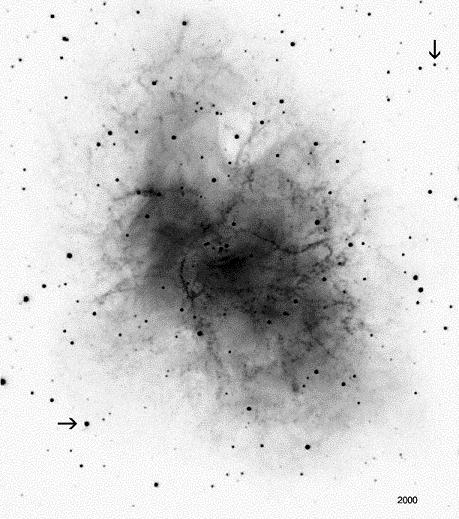 |
A crucial additional piece of evidence, is the peculiar spectrum of the visible light received from the Crab, sections of which are shown in Figure 10 and Figure 11. Alongside the continuous spectrum emitted from its central region, the overall spectrum of the Crab contains an array of discrete emission lines, originating mostly in the surrounding filaments, at wavelengths that are characteristic of certain known chemical elements.
|
Figure 10 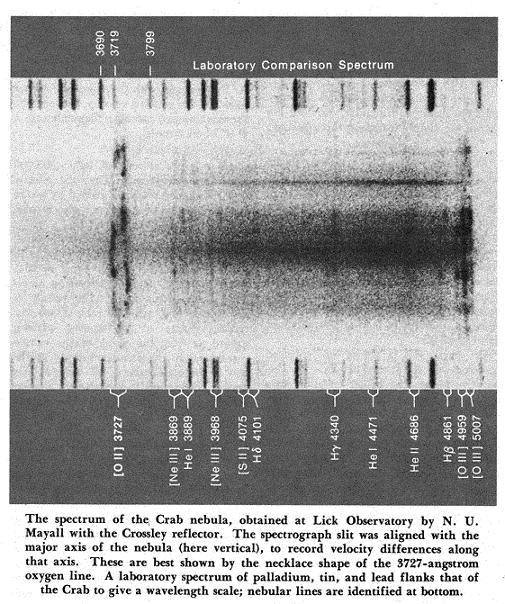
|
Figure 11 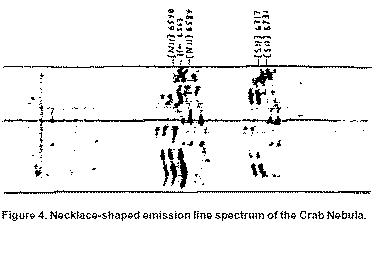 |
There is, however, a very striking difference to the Earth-bound spectra. The difference shows up most clearly in Figure 11, where the spectra of light from Crab Nebula is "scanned" at varying positions along its major axis. The strongest set of lines -- a group of three lines characteristic of the element oxygen -- appear "double" and split into two sets, expanding a "necklace"-like shape as the scan moves toward the middle of the axis. One set is "down-shifted" from their normal positions toward the longer wavelengths; the other "up-shifted" toward shorter wavelengths. Note that the gap is biggest in the middle of the Crab Nebula, while the two sets of lines approach each other toward the ends of the axis.
What is the Crab telling us, with this bizarre "necklace" of spectral lines?
So far I have mainly just described the observations, steering clear of any elaborate interpretations of the observed, anomalous characteristics of the Crab Nebula in terms of the "standard textbook knowledge" of physics. We are now approaching a point, where the application of "standard theory" can have the useful result, albeit of a negative sort: it leads us into what, for "standard theory" itself, is an insoluable paradox.
The splitting of the spectral lines from the Crab has a simple interpretation in terms of the known principles of propagation of light. Assuming the whole ellipsoidal "shell" of the Crab is indeed expanding -- as the angular growth of its projection on the celestial sphere suggests --, the light coming from the portions of the expanding "shell", that are expanding toward us, should be upshifted in frequency (i.e. toward shorter wavelengths); while the light from portions of the shell moving away from us will be shifted toward lower frequencies and longer wavelengths. Based on presently-known principles, the wavelengths of the emitted radiation would be expected to increase or decrease, respectively, by a proportional amount equal to the ratio of the velocity of expansion of the shell, to the rate of propagation of light.
Now, the actually observed magnitude of the upshift and downshift in the lines is on the order of 0,4% of the wavelengths involved. From the above reasoning we would have to conclude, that the rate of expansion of the Crab's shell were also of the order of 0.4 percent (or about 1/230th) of the rate of propagation of light -- corresponding, in linear-scalar terms, to a velocity of 0.4% of 300.000 kilometers per second, i.e. about 1300 kilometers per second. (This assumes, of course, that the characteristics and rate of propagation of light are the same in the vicinity of the Crab, as on Earth.)
But when we compare this estimate for the rate of radial expansion, derived from the magnitude of the spectral shift, with the apparent size and rate of expansion of the Crab as seen from the Earth, we come to the conclusion, that the Crab Nebula must be enormously large -- many light-years in diameter!
Recall, that the Crab's rate of radial expansion, as observed from the Earth, amounts to 0.1 second of arc per year. We just concluded, however, that light propagates 230 times faster than the radial motion of the outer filaments of the Crab. That would mean that a light wave, propagating along the Crab's major axis, would traverse in one year a segment 230 times longer than the yearly increase in distance from the center. The angular size of that segment, as seen from the Earth, would therefore be about 230 x 0.1 seconds of arc = 23 seconds of arc, or about 0.38 minutes of arc on the celestial sphere. As I mentioned earlier, the apparent major axis of the Crab corresponds to roughly 5 minutes of arc on the celestial sphere. Our conclusion: a light wave would take 5/0.38 years, or about 13 years, to propagate from one end of the Crab to the other!
More refined estimates, based on the same method, yield something closer to 10 light-years for the major axis of the Crab. For such a length to subtend an angle of 5 minutes for arc, as seen from the Earth, the distance of the Crab Nebula from the Earth would have to be about 6300 light years. At least, this is what simple geometry would lead us to conclude.
The shadow of a physical principle
The above estimates serve to clinch the paradox of the Crab's coherent behavior, which I already pointed out in discussing the time-lapse movie.
If, on the one hand, we assume that the Crab is really such an immense object as the above argument implies, then how is the Crab able to maintain the synchronicity and coherence of the rapidly chaning processes occuring in different regions, situated many light years apart? That coherence could only be due to a "something" that were acting isochronically, at all loci of the Crab simultaneously!
If, on the other hand, the assumptions underlying our estimate of the size of the Crab are invalid, then "something" is acting to the apparent effect, of drastically changing the assumed characteristics of the emission and propagation of light, and the assumptions of geometry, upon which our estimate of the scale-dimension of the Crab Nebula was based.
Either way, the anomaly of isochronic action "outside" the domain of the "standard physics" accounts of "chains of cause and effect" cannot be made to disappear. Different attempts at interpretation mere change the location and apparent form of the anomaly -- just as different methods of mapping a curved surface onto a flat plane, "blow up" in different ways.
It is by focussing in on this sort of irreducible paradox, that we become able to go beyond the Sensorium and any formalistic interpretation of the Sensorium, to conceptualize the real object that has generated the anomaly.
A number of other, gross anomalies of the Crab Nebula should be brought into the picture, that share the same underlying character. (A more rigorous treatment, to be developed, would replace the scalar measures, employed in the following brief exposition, by appropriate geometrical magnitudes for a corrected, anti-Euclidean representation of the Sensorium.)
Chief among the anomalies to be mentioned, is the circumstance, that the Crab Nebula is a powerful emitter of cosmic rays -- in fact, one of the most powerful ones known -- in the form of photons of ultra-short-wavelength light (gamma rays) having wavelengths trillions of times shorter than those of visible light, and thereby quantum energies many orders of magnitude larger than all known types of nuclear reactions, including presently known forms of "matter-antimatter" reactions.
In fact, the entire spectrum of radiation emitted from the Crab Nebula is drastically "upshifted" relative to that of our Sun. While our Sun has most of its output in the visible and near-visible range, most of the gross power output of the Crab is in X-rays, with a substantial part extending into the gamma-ray region. Combining the above estimate of the scale-dimensions of the "Crab" and of its distance from the Earth, with the intensity (brightness) of the radiation received in the vicinity of the Earth, one arrives at the conclusion, that the overall radiation output of the Crab Nebula must be approximately one hundred thousand times that of our Sun, but with the greatly "upshifted" spectrum.
Recently additional anomalies have come to light, which are coherent with the same "curvature". It was discovered last year, that the periodic electromagnetic pulses, attributed to the central star (pulsar) of the Crab, contain high-power subpulses lasting only about 2 billionths of a second. On the assumption, that the known characteristics of light emission apply to the Crab, the effective sources of such nanosecond subpulses could be no larger than about 60 centimeters across -- the distance light travels in 2 nanoseconds! But to produce signal of the observed strength at the Earth 6000 light-years away, the emitting region would have to achieve a power-density corresponding to a billion times that generated in the core of an H-bomb detonation! Alternatively, the effect of a tiny source region could be schieved through isochronic, coherent emission from a larger region of the Crab, according to the principle of a laser.
In both cases, "something" is acting to "shape" the Crab Nebula processes to the effect, of shifting its activity toward the higher energy-flux-density registers of coherent electromagnetic action. Let us look more carefully at this aspect.
Conical-spiral functions
All evidence points to the role of the Crab's pulsating star as the "motor" and "organizer" of the entire Crab Nebula, and to the likelihood, that this star is a rapidly rotating body, making one revolution every 33 milliseconds (30 cycles a second), which is the period of the star's apparent pulsation. The axis of rotation of that central star, would coincide with the axis of symmetry of the toroidal structure, revealed in the Chandra X-ray images, which in turn coincides roughly with the major axis of the ellipsoidal form of the Crab as a whole. From a very slight, but measurable slowing-down of the observed rate of pulsation it is surmised, that the Crab is constantly converting a portion of the rotation action of the pulsar, into various forms of electromagnetic radiation, and other forms of work that might be going on.
Now since electromagnetic radiation, as it projects into a generalized Sensorium, also has the characteristics of rotational action, the form of the general effect we are looking at, is the transformation of low-frequency action (rotation of the star at 30 Hz) into high-frequency registers of action (X-ray radiation at 10**17 Hz, gamma rays at 10**26 Hz or more).
Aha! What we have, minimally, is a form of conical spiral action: not simple rotational action, but rotational action which constantly transforms itself to higher registers of rotational action.
Let's not forget, however, that we are not dealing with a simple geometry. We have to locate the real object behind the images projected on the surface of our generalized Sensorium in different wavelengths -- and the conical-spiral characteristics of action adduced so far -- , within the real Universe: the Universe of three interconnected, Vernadskian phase spaces of nonliving, living and cognitive species of physical principles.
The flux of high-frequency radiation in the core of the Crab is such, that condensed matter, of the familiar earthly sort, could not exist there. Instead, we have a highly polarized plasma being acted upon by the rapidly spinning, intensely magnetic star -- a setup suited, we would presume, to actually generate, by polarized fusion or analogous sorts of processes, the kinds of organized forms of "matter" that would be a precondition for further evolution in the direction of a solar system in the direction of Biosphere and Noosphere phases of development. The conical function of "upshift" of electromagnetic radiation in the Crab would thus be multiply-connected with a second conical function, expressing the generation of an evolving "Mendeleyev table" of "eigenstates of matter" within the core region of the Crab.
This suggests the notion of a manifold of multiply-connected conical action, as a necessary feature of the region of tangency between an anti-entropic intention guiding a physical process, and the phenomena generated by that process in a generalized, spherically-bounded Sensorium. Therefore, the Crab Nebula should not be conceived as an object in a Euclidean-Cartesian "three dimensional space", but rather as a singularity in terms of that doubly-multiply-connected domain. (We can surely do better, but that is our first shot!)
Does the Crab Nebula have a "personality"?
The more we investigate the Crab, the more it closely it resemble the kind of object, that Lyndon LaRouche hypothesized, many years ago, as an early phases of development our own solar system:
"Currently, our best knowledge is, that the Solar system began as a fast-spinning, youthfully exuberant solitary Sun in the universe at large. According to Kepler's principles, this young Sun spun off some part of its material into a disc orbitting the Sun itself. If we assume polarized nuclear fusion occurring within that disk, then it were possible for polarized fusion, and, presumably, only polarized fusion, to have generated the observed periodic table of the Solar system. That fusion-generated material from the disk would have been "fractionally distilled" into approximately the Platonic orbits defined by Kepler."
Granted, this view of the evolution of the solar system is totally at odds with the "official" account, both in nominal content and, most importantly, in spirit.
Pick up any astronomy book or research paper, and you will find, in ritual propitiation to established academic doctrine, the Crab Nebula constantly referred to as a "supernova remnant". Note the implied, entropic misconception of the Universe, expressed by that expression. We are supposed to think of the Crab, not as a process evolving lawfully toward higher states of organization, but as a mere "remnant", a "left over" from an exploded star. In an aging, entropic Universe there would seem to be no room for the "youthful exuberence" of stars to generating their own, brand-new planetary or analogous systems. Not surprisingly, none of the astrophysical specialists predicted anything like the features revealed in 1999-2000 by the Chandra X-ray telescope, despite the elaborate ivory-tower mathematical models they develop to "explain", after-the-fact, earlier observations. In fact, Lyndon LaRouche has once again been shown on the mark, while the so-called experts were way off.
In reality the Crab Nebula displays all the characteristics of a happily evolving Keplerian system, including the driving, organizing role of its central singularity, in exact accordance with Kepler's conception of our Sun. The Crab continues its exuberant development, and no Earthbound pessimist can do anything about it!
This brings us back to the question, of the nature of astrophysical "objects". Is the Crab Nebula merely an "effect" or phenomenon of the overall laws of the Universe, like the attraction of magnets or the blue color of the sky? Or are we justified in associating to it a certain, individual character or personality -- a character that could only be known as a thought object to the mind? Certainly, the quality of exuberant passion, could pertain only to a Leibnizian monad, not a mere physical effect.
Any rigorous exploration of this question should adopt the Lyn's suggestion, from some years ago, to organize experimental scientific inquiry around a "3x3" schema: We make three rows, one for each of the three Vernadskian sub-phase-spaces of the Universe, corresponding to the domain of ostensibly non-living processes, of living processes, and of the processes associated with the action of cognition in the Universe. Then, we make three columns, corresponding to the microphysical, macrophysical and astrophysical ranges of scale-lengths of experimental investigation. To establish the validity of any purported universal physical principle, we must demonstrate its efficiency vis-a-vis all 9 of the 3x3 domains of experimental investigation -- the latter understood, of course, not in the sense of "objective science", but as domains subsumed by Man's action upon the Universe.
The most fascinating question, posed immediately by what we have said here, is the relevance of the Crab Nebula to the manifestations of the principle of life on the astrophysical scale.
Beyond that, do we not perceive a certain playful, daunting character to the anomalies, the Crab Nebula seems to throw at us? The face seems far away, but the smile is very close.